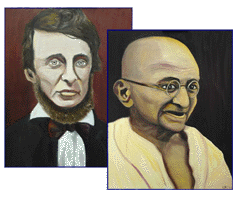"The whole aim of practical politics is to keep the populace alarmed (and hence clamorous to be led to safety) by menacing it with an endless series of hobgoblins, all of them imaginary." ~ H.L. Mencken
Money--Funny, Scary, Paper Money
Fifteen years ago I lived in Rio de Janeiro, Brazil. I spent a year there trying to be Paul Gauguin but found instead that I was a lesser artist: myself. At that time--1989/1990--few tourists traveled to Brazil. Rio was considered the most dangerous city in the world, with around 2,000-3,000 murders annually. If that weren't enough, inflation for 1989 was about 1,200% annually, as I recall. Each day you would see the value of the currency plummet in myriad ways. The daily newspapers (there were six) carried headline announcements, of course. Items in stores were often marked with three or four different prices and often whole shelves were emptied of a single item because smart shoppers knew the price would soon double.
I would walk or bus wherever I went. At the bus stop, I'd see money--coins & currency--scattered in the gutter. For the first couple of days, I'd pick up large and shiny coins and stare at their dates. A former coin collector, I'd wonder why a coin minted only a year ago now lay in the gutter. Valueless, my Brazilian friends would tell me, like the government. They had a few wonderful words--"safados"--scoundrels or "ladrones," which meant thieves, to classify their political leaders.
 At the time I arrived, you received three Cruzados Novo for each American dollar. This new "novo" cruzado was stamped (see photo) with a triangle designating its new value--or devaluation--over the old 1,000 cruzado note and reminded me of the Doctor Seuss story of the Sneetches, who had stars imprinted on their bellies so they too could attain a new value. In 1989, the Brazilian government decided to drop three zeros and change the name of the currency henceforth to Cruzado Novo. Since then the currency has been changed yet again to the Real.
At the time I arrived, you received three Cruzados Novo for each American dollar. This new "novo" cruzado was stamped (see photo) with a triangle designating its new value--or devaluation--over the old 1,000 cruzado note and reminded me of the Doctor Seuss story of the Sneetches, who had stars imprinted on their bellies so they too could attain a new value. In 1989, the Brazilian government decided to drop three zeros and change the name of the currency henceforth to Cruzado Novo. Since then the currency has been changed yet again to the Real.
It seems Brazil was busted from too much spending, the same sort of deficit spending America is doing in a big and scary way. All that borrowed money by Brazil, and the massive debt incurred, landed squarely on the shoulders of the average citizen when payment came due. To the average citizen, these were scary, stressful times. Paper money became a roller coaster ride; vendors, landlords and even prostitutes preferred US dollars. Wages were adjusted constantly to keep up with the inflation rate.
Frequently, on my walks, I would see large paper bills, 50,000 or 100,000 "old" Cruzeiros, in the gutter, but after awhile I never picked up any more money. I found it wasn't even worth a fraction of a cent. Likewise, at the beach you could see shiny coins roiling in the surf but no Brazilian bothered to retrieve them.
"By the mid-1980s inflation was out of control," wrote the editor of BrazilBrazil. "The good news was that the military were on their way out and democracy was on its way in. The bad news, however, was that the 'civilians' taking over were the old aristocracy from the north and northeast of Brazil (called 'coroneis', or coronels after the powerful, traditional landowners in the region). These presidents (Sarney and Mello) were so corrupt that they made the Generals look good."
Corruption and cronyism bankrupted that country. The currency of Brazil was a sad joke. After all, the credibility of a country is what gives its currency good standing in the world. Paper money must have either a foundation of precious metal to back it up--or government integrity for fiscal responsibility in the eyes of financial leaders. When both are lacking, that currency is doomed.
Years ago, America enjoyed both fiscal integrity and the backing of precious metal behind the paper it printed. No more. "For the last thirty years, since Nixon closed the gold window, the world has been on a paper money system. Never before has the world tried such a risky venture, and now dark clouds are gathering on the horizon," wrote Bill Haynes. "Investors who ignore the clouds are whistling past the graveyard. Now is a time to be afraid and the time to take steps to weather the storm."
One of the little discussed reasons for the invasion of Iraq by the US was because Saddam Hussein had almost convinced OPEC to demand payment in euros. Had that happened, the USA would have been as credible as Brazil and just as bankrupt. Representative Ron Paul, who wrote Raising the Debt Limit: A Disgrace, remarked that "the debt limit has become merely another technicality on the road to bankruptcy."
One of the most peculiar sights I saw in Rio during those crazy times involved a card table and a vendor. Piled atop the card table were stacks of crisp currency from years past. I never saw so much paper money! For pennies on the dollar you could purchase a thick wad of worthless money. For a few dollars I could have purchased a veritable fortune in yesterday's legal tender--now worthless. As America goes reeling towards bankruptcy, not just in the eyes of the world but financially, I wonder whether some future vendor might following this same example to survive.
Since I wrote Silver: The Precious Metal That Spurred the Conquest of a Continent, silver has climbed approximately $1.75 per ounce and has regained the luster that took it above $8 last April. Meanwhile, the US dollar has been pounded by just about every other currency in the world. As Bob Dylan said, "You don't have to be a weatherman to know which way the wind is blowing."
I'm not sure the US dollar's collapse will mean the end of the world, but it might make things rather uncomfortable. Nor do I suppose the euro will become the predominate currency. I'm not sure I agree with Bruce Porteous when he says, "The new Europe will be able to dictate the terms on how the global economy should be run." Our worldwide Gunboat Diplomacy might have something to say about that while the Neocons remain in power. However, when Federal Reserve Chairman Alan Greenspan warns about a trade deficit impact, and Warren Buffet begins to advise investors to delve into euros rather than dollars, something is up. The sky ain't falling yet, but the pillars that hold it up are showing some hairline cracks.








 Reprint Rights
Reprint Rights